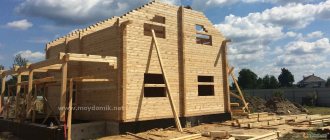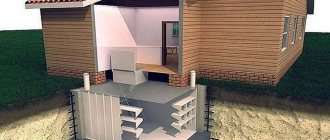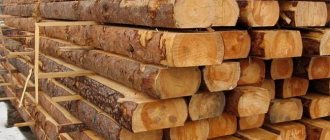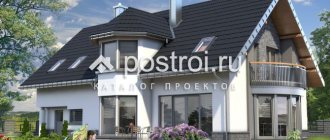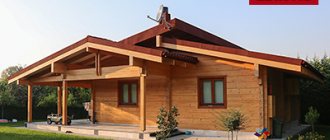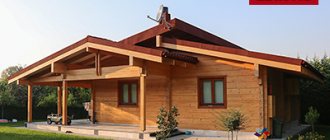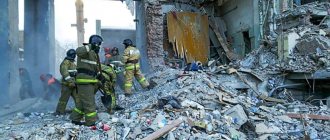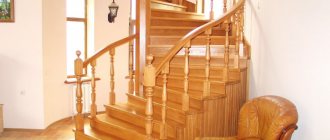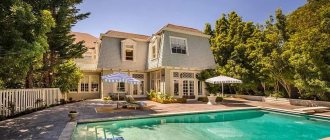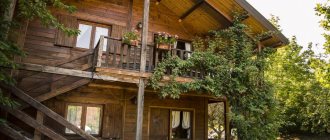Country houses are rarely built from LVL timber. It turns out to be an expensive pleasure. It differs from double timber in increased strength, reliability and more. It retains heat excellently. It is not afraid of severe frosts typical of the harsh Russian winter. Doesn't sit down. Does not deform under the influence of destructive external factors. Meets the current Russian state standard “GOST 33124-2014”. Check out its principles here. Want to know more? Read an honest review about the features, as well as the advantages and disadvantages of the building materials from which Americans built houses and cottages back in the thirties...
Necessary explanations for calculations
- Height and width determine the cross-sectional area and mechanical strength of the beam.
- Wood material: pine, spruce or larch - characterizes the strength of the beams, their resistance to deflection and fracture, and other special performance properties. Usually preference is given to pine beams. Larch products are used for rooms with a humid environment (baths, saunas, etc.), and spruce beams are used in the construction of inexpensive country houses.
- The type of wood affects the quality of the beams (as the grade increases, the quality deteriorates). 1st grade. On each one-meter section of timber, on any side there can be healthy knots measuring 1/4 of the width (face and edge), and 1/3 of the width (edge). There may also be rotten branches, but their number should not exceed half of the healthy ones. It should also be taken into account that the total dimensions of all knots in an area of 0.2 m must be less than the maximum width size. The latter applies to all grades when it comes to load-bearing beam structures. There may be plate cracks measuring 1/4 of the width (1/6 if they extend to the end). The length of through cracks is limited to 150 mm; first grade timber can have end cracks up to 1/4 of the width. The following wood defects are allowed: tilting of the fibers, tilt (no more than 1/5 of the side area of the beam), no more than 2 pockets, one-sided growth (no more than 1/30 in length or 1/10 in thickness or width). Grade 1 timber may be affected by fungus, but no more than 10% of the lumber area; rot is not allowed. There may be a shallow wormhole on the wane parts. To summarize the above: the appearance of such timber should not cause any suspicion.
- 2nd grade. Such a beam can have healthy knots measuring 1/3 of the width (face and edge), and 1/2 of the width (edge). For rotten knots, the requirements are the same as for grade 1. The material may have deep cracks up to 1/3 the length of the timber. The maximum length of through cracks should not exceed 200 mm; there may be cracks at the ends up to 1/3 of the width. Allowed: inclination of fibers, heel, 4 pockets per 1 m., sprouting (no more than 1/10 in length or 1/5 in thickness or width), cancer (extending up to 1/5 of the length, but not more than 1 m) . Wood can be affected by fungus, but not more than 20% of the area of the material. Rot is not allowed, but there can be up to two wormholes in a 1 m area. To summarize: grade 2 has borderline properties between 1 and 3, and generally leaves a positive impression upon visual inspection.
- 3rd grade. Here the tolerances for defects are greater: the timber can have knots measuring 1/2 the width. Face cracks can reach 1/2 the length of the lumber; end cracks measuring 1/2 the width are allowed. For grade 3, it is allowed to bend the fibers, tilt, pockets, core and double core, sprouting (no more than 1/10 in length or 1/4 in thickness or width), 1/3 of the length may be affected by cancer, fungus, but not rot are allowed. The maximum number of wormholes is 3 pcs. per meter To summarize: grade 3, even to the naked eye, does not stand out as the best quality. But this does not make it unsuitable for the manufacture of floors on beams. For more information about the varieties, read GOST 8486-86 Softwood lumber. Technical specifications;
Our online calculator will allow you to calculate the parameters of wooden beams and select the optimal floor configuration.
Loading…
Scope of application of LVL timber
The assortment, as you may have noticed, is quite wide. Manufacturers produce monolithic slabs, roofing panels, load-bearing structures, as well as timber for mounting the foundations of frame buildings and load-bearing floor structures. In addition, part of the raw materials is used to create fencing materials.
Houses made of LVL timber
However, the most attractive option is the possibility of building houses from this material. Some people prefer to use pressed timber as frame structures, while others prefer to use them for the construction of roofs and ceilings.
The advantage of such buildings is fast installation time; they are usually erected within a season. Most often, the entire process does not take more than 3 months. As an example, we can give a project for a frame house with an attic.
LVL timber can be used for the construction of: roof rafters, internal partitions and ceilings, interfloor partitions and external walls.
Certain types of products made from LVL timber
LVL timber can be used as arches for street structures: cafes, open areas, stages, construction of farms and hangars, monolithic structures for the construction of modular housing, as well as staircases. The price of LVL timber will depend on many factors: the quality of the veneer, the number of layers, raw materials.
1 of 6
WAREHOUSES IN MOSCOW, ST. PETERSBURG AND NIZHNY NOVGOROD
- Sawing
- Grinding
- Painting
- Impregnation
- Sawing
- Grinding
- Painting
- Impregnation
or laminated veneer lumber - a high-strength multi-layer timber designed to create durable load-bearing structures.
It is actively used in private and industrial construction, sports facilities where it is necessary to cover spans of up to 30 meters.
One of the best materials for the construction of frames, rafters and interfloor ceilings. x2 times stronger than wood! no shrinkage, perfect geometry, natural material (wood).
The best material made from natural wood. Strength is x2 times higher, eliminates floor creaks and deformation. Ideal geometry. Does not absorb moisture, does not crack. It doesn't burn well.
The ideal accuracy of cross-section and length allows you to radically reduce the consumption of LVL timber compared to conventional lumber, for example, a rafter group made of LVL, taking into account all elements (rafter leg, fillet, front board, rough filing, box, support beam, mauerlat, sheathing, counter lathing and etc.) has a consumption of 0.04 m3 per 1 m2 of roofing, which is 2.5-3 times lower than the consumption of conventional edged lumber.
Implement modern technologies today!
Between floors there are fewer partitions and walls, and the floor does not move underfoot. With LVL timber it is easy to make complex floors. It also has greater fire resistance due to its structure.
Rafters of the required length (up to 30 meters) and minimal load on the walls and foundation. Much more additional meters due to the absence of vertical jibs. Ideal for the construction of country houses, gyms, swimming pools, and other long-span buildings.
without strengthening walls, installing columns and investing in a reinforced foundation. Power floors made of LVL timber can withstand a load of 500 kg per square meter.
A LVL structure weighs significantly less than its analogues (in any case), so there is no need to spend significant sums on strengthening the foundation and walls.
We have been selling LVL/LVL timber since 2005. In 2022, after 13 years of wholesale trade in LVL timber, small wholesale and retail sales were launched.
The company has offices and warehouses in 3 cities: Moscow, St. Petersburg and Nizhny Novgorod, which allows you to quickly receive materials in the European part of Russia and gives you the opportunity to visit the warehouse to assess the quality of the material.
We are an accredited supplier to the largest developers in Moscow and St. Petersburg: LSR Group of Companies, PIK Group, Krost and Samolet Development. Dozens of construction companies cooperate with us. We invite you to cooperation.
We calculate structures from LVL timber
The Ultralam 2.0.4 calculator program is designed for calculating the structures of multi-span beams made of laminated laminated timber LVL. If you find it difficult to calculate the design yourself, you can send it to us for calculation.
| on the edge | N/mm2 | 48,0 |
| size influence parameter | 0,15 | |
| on the surface | N/mm2 | 50,0 |
| Tensile strength: | ||
| parallel to the grain | N/mm2 | 36,0 |
| Compressive strength: | ||
| parallel to the grain | N/mm2 | 38,0 |
| perpendicular to the grain, on the edge | N/mm2 | 6,0 |
| perpendicular to the grain, on the face | N/mm2 | 3,0 |
| Shear strength: | ||
| on the edge | N/mm2 | 5,0 |
| Elastic modulus: | ||
| parallel to the grain (average value) | N/mm2 | 14000,0 |
| parallel to the fibers (5% quantile) | N/mm2 | 12000,0 |
| Shear modulus: | ||
| on the edge | N/mm2 | 350,0 |
| Density | kg/m3 | 480,0 |
| Fire resistance class | E | |
| Formaldehyde emission class | E1 | |
| Wear resistance class | 4 |
| LVL Ultralam X laminated veneer lumber |
It is used as wall panels, wooden ties, etc. About 20% of the veneer layers in the slab are glued in the transverse direction.
| Type of wood | Fur tree, pine tree | or mixture |
| Thickness | 24mm | from 24mm to 75mm |
| Strength tests Surface tests | ||
| Bending strength of paired fibers1) | 44 | 49 |
| Flexural strength of per-fibers | 9 | 12 |
| Compressive strength of per-fibers | 4,2 | 4,2 |
| Shear strength | 2,7 | 2,7 |
| Edge tests | ||
| Flexural strength1) | 30 | 40 |
| Tensile strength of steam fibers | 18 | 24 |
| Tensile strength of per-fibers | 6,2 | 5 |
| Compressive strength of steam fibers |
2634 Compressive strength of per-fibers—8 Shear strength 33 Stiffness tests
^Values refer to H?300mm. For H greater than 300mm, the characteristic strength value must be multiplied by the coefficient kN = (300/H)0.15. H is the height of the overall cut for the corresponding bending test in mm Test results from the Materials Testing Agency, University of Stuttgart
| RECOMMENDATIONS FOR RESISTANCE CALCULATIONS |
Approved by TsNIISK im. V.A. Kucherenko – Branch of the Federal State Unitary Enterprise Research Center “Construction”.
| Design resistance, MPa | Ultralam™ type | ||
| R s | R | X | I |
| 25,7 | 23,6 | 19,8 | 22,1 |
| 4,3 | 3,5 | 6,8 | 3,8 |
| 1,9 | 1,7 | 1,9 | 1,7 |
| 26,9 | 22,5 | 17,5 | 16,9 |
| 27,3 | 26,8 | 19,6 | 23,7 |
| 35,5 | 27,8 | 24,1 | 22,9 |
| — | 2,6 | 2,6 | — |
| — | 1,1 | 1,1 | — |
Calculation of load-bearing and enclosing structures using multi-layer laminated veneer material Ultralam must be carried out in accordance with STO 36554501-002-2006 and STO 36554501-020-2009.
When operating building structures exposed to various factors (temperature and humidity conditions, elevated temperatures, exposure to constant and temporary long-term loads), the calculated resistance values are multiplied by coefficients adopted in accordance with STO 36554501-002-2006 and STO 36554501-020-2009 .
| RECOMMENDATIONS ON ELASTIC MODULES |
The values of the modulus of elasticity along the fibers of multilayer laminated veneer material Ultralam™ of various types, accepted for structures of class 1 operation, protected from heat, moisture, and under constant and temporary loads:
| Elastic modulus E, MPa | Ultralam™ type | ||
| R s | R | X | I |
| 15 600 | 14 000 | 11 000 | 12 700 |
| CHARACTERISTICS OF OPERATING CONDITIONS OF STRUCTURES |
| Service class | terms of Use | Recommendations for use |
| Relative humidity, % | Air temperature, °C | |
| 1 | 40-60 | 20±5 |
| 2 | 60-80 | 20±5 |
| 3 | above 80 | above +25 and not below -30 |
FSC's goal is to promote environmentally responsible, socially responsible and economically sustainable forest use and management of the world's forest resources.
Environmentally responsible forest management ensures that the harvesting of timber and non-timber forest products does not threaten biodiversity or reduce forest productivity or ecological functions.
Socially oriented forest management provides both the local population and society as a whole with the benefits of forest management in the long term, and also creates incentives for local people to conserve forest resources and conduct forestry based on long-term planning.
Economically sustainable forest management means that forest management is designed and carried out in such a way that it provides sufficient economic benefits without losses to forest resources, ecosystem quality and without harm to the local population.
Detailed information about FSC certification is available on the website www.fsc.ru.
TsNIISK them. V.A. Kucherenko
Central Research Institute of Building Structures and Structures named after. V. A. Kucherenko is one of the oldest scientific organizations in the country’s construction complex. The history of its creation dates back to 1927, when, by decree of the Supreme Council of National Economy of the USSR, the State Institute of Constructions - GIS was created, in 1931 transformed into the Central Scientific Research Institute of Industrial Constructions (TsNIIPS), on the basis of which the TsNIISK Institute was created in 1957. Currently, TsNIISK is a branch of the Federal State Unitary Enterprise “Research Center “Construction”.
TsNIISK them. V. A. Kucherenko - carrying out leading functions in the field of the theory of structures and structural mechanics; development of fundamentally new forms of metal, stone, wooden structures, structures using plastics, as well as technologies for their production; seismic resistance, vibration protection and fire resistance of building structures, buildings and structures. In all these areas, the institute also carries out certification and licensing work.
Detailed information about TsNIISK im. V. A. Kucherenko on the website www.cniisk.ru.
The main activity is ensuring the quality and reliability of wooden, including laminated laminated structures, at the stages of design, production, installation and operation. ELST STROY provides technical support for the organization of production of wooden laminated structures, quality control of manufactured structures, preparation for obtaining certificates of conformity, as well as inspection, assessment of the technical condition and restoration of exploited wooden structures of walls, floors and coverings of residential, administrative, sports and entertainment, warehouse and others buildings and structures. During a comprehensive inspection of buildings, structures made of other materials are also examined.
The ELST STROY company was created in collaboration with the quality control sector of the laboratory of wooden structures of the TsNIISK named after. V.A. Kucherenko.
For floor structures, very important characteristics are strength, rigidity and durability. LVL beams fully comply with these requirements. They are not only able to withstand enormous mechanical loads, but are also resistant to aggressive environments. Laminated timber floors are lightweight. This allows you to significantly speed up their installation using a minimum of equipment.
Areas of use of LVL timber: studying the issue
Due to its physical properties and good characteristics, LVL timber is used in the construction of houses and other structures, if it is necessary to create durable building structures, such as:
- rafters and other structural elements of the roof;
- frame house construction;
- load-bearing structures of buildings and structures of complex geometric shape.
In addition, this material is used in the manufacture of individual elements of building structures, which during operation are subject to significant mechanical loads, these are:
- staircases and openings;
- arches and other light open structures used in the construction of summer verandas and cafes.
High strength and resistance to external influences allow the use of LVL timber in the manufacture of complex structures operated in harsh conditions
Wooden floor construction
Wooden flooring is inferior in strength and rigidity to reinforced concrete, so it is installed in residential buildings up to four floors. Beams are made from coniferous wood (pine, spruce, fir, etc.). The length of the beams is most often 5–6.5 m. In stone buildings, the beams are laid at a distance (along the axis) that is a multiple of the size of the brick or blocks.
1. Blind seal. 2. Open termination. 3. Butt connection of beams. 4. Connecting beams staggered. a - brick wall, b - beam, c - internal support, d - metal overlay e - waterproofing
Beams are embedded in external stone walls using a blind and open method. Regardless of the method of sealing, it is necessary to take measures to prevent condensation of air vapor in the wall cavities. This occurs when their thickness is less than two bricks. In thicker walls, condensation does not form in the sockets.
The depth of the socket for supporting a beam in stone buildings, based on the compressive strength of the masonry, is taken to be 0.6–0.8 h (h is the height of the beam). The minimum permissible support size is 150 mm. Usually it is taken 180–200 mm. In this case, the beam should not reach the wall by 3–6 cm in order to ensure air access to its end.
The floor beams are impregnated with antiseptic compounds, and the end is necessarily insulated with two layers of waterproofing (tar paper, glassine). The space between the wall and the side surface of the beam is filled with mortar.
Every third beam must be connected with an anchor to the outer wall. The anchor is embedded at one end into the wall, and the arced end is attached to the beam. They are also connected to each other when supported on the internal walls.
The subfloor is laid in two ways:
- Shields or boards are laid on the skull blocks using overlay strips.
- Continuous laying of shields (boards) directly on the skull blocks.
Beams and logs are lined from below with boards made of thin boards, gypsum plasterboard, gypsum fiber board, OSB or other sheet materials. Membrane insulation is laid, on which a heat and sound insulating layer is laid. This can be bulk, slab or roll insulation placed between the beams.
1. Floor beams. 2. Binder. 3. Subfloor. 4. Insulation 5. Vapor barrier
A vapor barrier layer is also placed on the thermal insulation. Next, a clean floor is installed, which can be attached to the joists or directly to the beams. The logs are laid on the floor beams. A gap is left between the insulation and the upper edge of the beams to allow air access to the wooden floor structures.
The coating of the floor and ceiling depends on the operational performance of the room and the interior design solution. Almost any floor can be made using wooden beams (planks, parquet, linoleum, ceramic tiles, etc.).
The beams are attached to each other using special metal products.
Production
The process of manufacturing LVL timber is quite energy-intensive, costly, and requires the use of complex technological equipment:
- The raw materials entering the factories are cleared of bark and immersed in special pools for 1–2 days. Saturation with moisture facilitates further cutting and peeling of wood.
- After the initial and hydrothermal treatment of the logs has been carried out, they are sawed and peeled to obtain veneer. The thickness of the sheets should be no more than 3 mm. Rejected specimens are subsequently used to produce low-quality material suitable for the construction of fences.
- The lumber is then cut to required sizes and dried. The finished veneer should contain about 5% moisture.
- After sorting, the selected sheets are glued and pressed into a single sheet of 9 to 24 pieces. The resulting conglomerate is cut according to the required dimensions: in the form of slabs, beams or beams.
- The finished product is checked for compliance with all parameters, packaged and labeled.
When cut, the material resembles the structure of a dense layer cake due to alternating thin strips of veneer and glue.
Manufacturers
In Europe and Russia there are not many enterprises producing LVL timber. This is explained by the complexity of production technologies, as well as the consumer’s low awareness of the advantages of this material. Russian developers are just beginning to master it.
The cost of products is calculated taking into account the species and types of wood used, density, and number of veneer layers. The price of 1 m³ of material is 25,000–36,000 rubles.
The table lists the largest manufacturers producing LVL timber
| Firm | Trademark | Location |
| LVL-Ugra | UGRA (Ugra) | Tyumen, Russia |
| Talion-Terra | ULTRALAM (Ultralam) | Tver, Russia |
| Finnforest | Kerto (Kerto) | Finland |
The range of Russian manufacturers includes types of timber used for the construction of load-bearing and enclosing structures, floor slabs, roofing panels, and floor elements. Domestic material has managed to prove itself from the best side and has shown that it is in no way inferior to foreign analogues.
Get estimate/project
Estimate only for customers in St. Petersburg, Moscow, Leningrad and Moscow regions
We have identified your region as Samara. If the construction site is located in the Moscow or Leningrad regions, indicate it in the message field
Attention! Estimates are calculated only for customers in St. Petersburg and Moscow . For construction in other regions, estimates are not provided .
Are you planning construction in St. Petersburg, Moscow, Leningrad or Moscow regions?
Production technology
All characteristics of the material are achieved precisely thanks to special production technology. What is it? This is a high-tech process that takes place in several stages. It is clear that each production has its own technological features and subtleties.
However, the process is almost identical and boils down to the following order:
Logs are fed onto the conveyor, from which the bark is removed. After that, a layer up to 3 mm thick, called veneer, is removed from each log. The finished veneer strip is cut into slabs of a certain size, sorted by moisture content and fed into drying chambers. There they lose up to 5% moisture. After which the dried veneer is sorted by quality and external characteristics. An adhesive is applied to the veneer, the slabs are laid on top of each other with an overlap, after which they undergo a pressing process. During this time, the layers are securely glued to each other. After all the LVL processing, the timber is cut according to size, quality checked and packaged.
You can see the process of making the material in this video:
Determining the cross-sectional dimensions of a wooden beam using formulas
More often, the load-bearing elements of an interfloor or attic floor are beams with one span and free support on a load-bearing wall or pillar.
1. Round log. 2. Beam with two edges. 3. Beam, four edges. 4. Composite beam. 5. LVL timber. 6. Nascor beam 7. Board
They absorb bending from the weight of the entire floor and temporary payload (furniture, people, etc.). The required dimensions of the beam are determined by calculation. The condition for this is the specified strength and rigidity of the load-bearing element.
To determine the loads on the beam, the density of coniferous wood for the structures of premises with normal operating conditions is assumed to be 500 kg/m3. For wet rooms and outdoor structures - 600 kg/m3.
The tensile strength of coniferous wood working in bending is 75 MPa. The rigidity index (elastic modulus E) determines its ability to deform under the action of any loads.
For normal operating conditions of structures under loads:
- E = 10,000 MPa - along the fibers;
- across the fibers, the E index decreases almost 50 times.
Temperature also affects the reliability of wood. If it increases, the tensile strength and elastic modulus decrease. This increases the fragility of wooden products. The same thing happens when exposed to negative temperatures.
To calculate any structure, standard and design loads are determined. The design load is obtained by multiplying the value of the standard load by n - the reliability factor (overload), which takes into account the conditions under which the structure operates.
The strength of the beam is checked by the action of the maximum bending moment:
σ = М/Wр ≤ Ri
- σ is the stress in the beam;
- Wр - design moment of resistance;
- Ri is the calculated bending resistance, which for coniferous wood is 13 MPa.
The selection of the cross-section is calculated based on the required moment of resistance Wtr:
Wtr = M / Ri
For a rectangular section:
For round sections:
Stiffness is checked against standard loads:
- f is the maximum deflection of the beam;
- l is the design span of the beam in cm;
- f/l - relative deflection, which should not exceed: 1/250 - for floors between floors; 1/200 - for attic floors;
- J is the moment of inertia in cm4;
- qн - standard load in kg/linear. cm;
- E = 10,000 MPa, 100,000 kg/cm2 - elastic modulus of wood;
- c is the maximum permissible coefficient for the ratio l/h, where h is the height of the beam section: 18.4 - for interfloor ceilings; 23.0 - for attic floors.
In the case where l ≤ ch, beams are checked only for strength. If l > ch, they are checked only for rigidity.
For example, let’s calculate a wooden beam for an interfloor floor. Span l = 4.5 m; floor weight - g = 200 kg/m2; temporary load p = 150 kg/m2; the distance in plan between the axes of the beams is a = 0.9 m; beam material - pine Ri = 130 kg/cm2; m operating condition coefficient is 1.0.
Design load for 1 linear line. m element:
q = (gнn + pнn1) · a = (200 ∙ 1.1 + 150 ∙ 1.4) ∙ 0.9 = 387 kg/linear. m
- n, n1 — reliability coefficients of permanent and temporary payloads.
The moment of resistance that is required is determined from the strength condition:
Table of moments of resistance W in cm3 of rectangular sections
| b | h | ||||||
| 8 | 9 | 10 | 11 | 12 | 13 | 14 | |
| 21 | 588 | 661 | 735 | 808 | 882 | 955 | 1029 |
| 22 | 645 | 726 | 807 | 887 | 968 | 1049 | 1129 |
| 23 | 705 | 793 | 882 | 970 | 1058 | 1146 | 1234 |
| 24 | 768 | 864 | 960 | 1056 | 1152 | 1248 | 1344 |
| 25 | 833 | 937 | 1041 | 1146 | 1250 | 1354 | 1458 |
| 26 | 901 | 1014 | 1127 | 1239 | 1352 | 1465 | 1577 |
Using specially calculated tables, you can select the rectangular cross-section of the element - bxh. We accept timber 8x24 cm (W = 768 cm3). In the case under consideration, the ratio l/h = 450: 24 = 18.75, and the maximum permissible c = 18.4 for interfloor ceilings. Based on this, deflection calculations are not performed.
How LVL timber is produced
First, using special equipment, the bark is removed from the tree trunk (the log is debarked). Next comes peeling, drying and sorting of the veneer. The best veneer is selected for the production of LVL timber. Without the slightest defect.
Afterwards, the veneer is glued together under a special press. The strength ratings of LVL timber are due to the fact that the veneer is glued together so that each layer is positioned so that the grains are parallel to each other.
How many layers
In LVL timber, as a rule, there can be up to 24 layers of veneer. But most often, timber is used whose thickness does not exceed 7-9 layers of veneer. The final stage of production is cutting the timber to the required dimensions and packaging it.
- The thickness of the timber may vary. In the range from 1.8 to 10.2 cm.
- The length of the beam can reach 18 meters, width - 1 -1.8 cm
Why is it better to contact us?
Our company offers a huge variety of such products. Here you can find floor beams made from LVL timber of various sections and lengths. At the same time, the load-bearing capacity of the offered products, depending on the characteristics of their composition, can vary significantly. Our specialists will help you choose the type of LVL required for each specific case and calculate the required volumes of building material. For large wholesale customers we provide a fairly flexible system of discounts. We guarantee the quality of our products, and if necessary, we provide delivery and installation.
Leading manufacturers of LVL timber
As we noted at the very beginning of the article, in Russia there are only two large manufacturers that produce LVL timber. However, this does not mean that only these two enterprises have completely captured the market. There is another foreign manufacturer in Russia that very confidently occupies this niche.
Timber from the Kerto brand (Finland) is bought quite well for the construction of various kinds of prefabricated frame objects
The second Russian manufacturer is LVL-YUGRA, the company is legally registered in Tyumen, but production has been opened in several cities of the Khanty-Mansi Autonomous Okrug, the first of which appeared in the city of Nyagan.
Advantages and disadvantages of LVL timber
c http-equiv=”Content-Type” content=”text/html;″>lass=”article_show_context_1″>
Now we move on to the sweet part, comparing the pros and cons of the material. After all, these are the indicators that characterize the material. After all, everyone who wants to build a house must know all the strengths and weaknesses of the proposed material. Let's start with the advantages:
High strength. We have already noted that even the strongest laminated veneer lumber with identical parameters is inferior to LVL products in strength. Why? The best wood was selected, without visible defects or defects. Product homogeneity. Taking into account the fact that the timber has no defects, its properties and characteristics will be the same over the entire area of the material. This is important when creating long spans. Stability and no shrinkage. Throughout its operation, the geometric size of the tree will be maintained, even with temperature fluctuations and high humidity. Moreover, you will not see cracks on the surface of the products, which can spoil the appearance and reduce reliability. The material has excellent heat retention and noise reduction properties. If you wish, you can insulate the house with any insulation material, since wood can be combined with all types. Due to its light weight, working with wood is convenient and easy. You will not need any heavy equipment to build your house. Accordingly, the structure will also have a light weight and will not load the foundation as much. Possibility to build a house with a wide variety of architectural features. Durability. The material can last for many years, which is determined by its characteristics.
As you can see, LVL timber has a lot to appreciate. Its characteristics are very good, which allows the material to be used even in cold regions. And if we talk about the downsides, there are very few of them. We can say that the list is the same as for laminated veneer lumber. What is it about?
Firstly, due to high-tech processing and selection of the best material, the cost of products is quite high. Not everyone will be able to afford to build such a house, especially taking into account the average salary. After all, on average, 1 m3 of products can be purchased for at least 25 thousand rubles. Even glued laminated timber costs 2 times less, not to mention regular timber. As they say, you have to pay for quality.
Secondly, glue (formaldehyde) is used in production, so the safety of the material is called into question. However, if all technological processes and rules were followed during production, then the release of harmful substances will not exceed the permissible limit. And if you consider that it is precisely because of the adhesive composition of LVL that the timber burns so poorly, then it seems that this is not a problem at all.
Note! When purchasing material, pay attention to quality certificates and relevant documents. This way you can protect yourself from buying low-quality products that can only harm your health.
Scope of use of LVL timber
But what is this unique material used for? With such characteristics, is everything really limited to building a house? Not really. The products have a wide range of applications, which we will discuss further.
Construction of frame buildings. Due to the accuracy of the final raw materials, uniformity over the entire surface and strength along with load-bearing capabilities, such buildings can be considered the best. And the timber itself is easy to process, so the work can be done with your own hands. For the construction of hangars and other prefabricated structures.
Installation of truss systems for houses. After all, its important features are strength and light weight. Therefore, many even replace LVL metal with timber. Individual beams can be used as decorative elements.
The material is used to make formwork for pouring concrete. And due to their properties, the products can be reused.
Areas of application
Laminated LVL timber is used in the construction of private low-rise buildings - house frames are made from it. Beams and various components of the rafter system are often replaced with beams. Using LVL lumber they build:
- hangars;
- garages;
- sports halls;
- kiosks;
- various commercial and industrial buildings;
- interfloor ceilings;
- roofing panels and fencing structures;
- formwork for subsequent pouring of concrete solution.
The material is also used for the manufacture of doors, windows, furniture, arched structures, and interior decorations. Due to its high moisture resistance, it is in demand when constructing buildings with high humidity levels (for example, baths and saunas). LVL timber has many advantages, but due to the high price of about 30,000-40,000 rubles. /m3 it is unprofitable to build walls from it. However, this is one of the best building materials, with the help of which various auxiliary structures are erected - support pillars or beams. To reduce the cost of building a house, it is recommended to combine it with other types of beams.
Level reduction - what is it?
In computer gaming terminology, there are a large number of universal terms that you can use in any case, and everyone will understand you. These terms also include the concept of lvl, which you should definitely know.
What is lvl? It's not actually a term, but an abbreviation that is used in chats to write fewer characters. This term completely sounds like “level” and means the level of the character in the game. Its origin will be obvious to those who speak English - it comes from the word level, which translates as “level”. But the word “level” is usually used in colloquial speech - during a conversation about a game or during negotiations over a speakerphone. If you use game chat as a means of communication, then it will be easier for you to write just lvl, not level. It would seem that only two symbols make a difference, but in particularly tense moments they can also save. Moreover, other terms are also abbreviated in most cases, and as a result, in one phrase you can save up to ten or even more characters, which already gives you quite a lot of time. Now you know what lvl is, but you also need to understand under what conditions this abbreviation is used.
